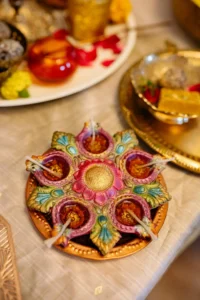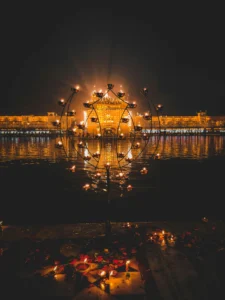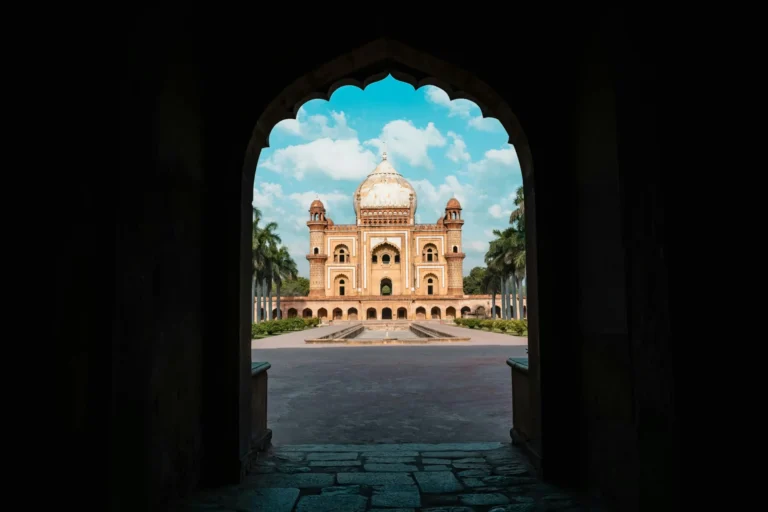Have you ever stepped into a Hindu temple during Diwali or been in an Indian locality? You might come to realise that it’s not just about the diyas or the lamps or the firecrackers, or about the delicious sweets. It’s so much more than all this. It’s about triumphing over evil. There is something more in the air. Some kind of vibe which you can only feel, not just see from your eyes. There is so much devotion, memory, joy, and lights.
Most people outside India know Diwali as the “Festival of Lights,” and that’s not wrong. But in temples, that phrase takes on a richer meaning. This isn’t about string lights or crackers, it’s about light as something sacred, something symbolic. Light that drives away ignorance, ego, and fear. Light that stands for truth.
I remember walking barefoot into a small temple in Kanchipuram once, right before Diwali. The priests were prepping for Lakshmi Puja. You could smell the ghee and incense. It wasn’t loud or grand. But you could feel something ancient moving through the place.

Table of Contents
ToggleWhy is diwali celebrated?
Diwali isn’t one story. It’s many. In the north, people celebrate Lord Rama’s return to Ayodhya after 14 years of exile. Down south, it’s more about Krishna defeating Narakasura. In Gujarat, it marks the end of the financial year. Same festival, different meanings and each one plays out differently in temples.
Despite the variations, the soul of Diwali stays the same light over darkness, good over evil. And temples are where that story is told most faithfully.

Diwali Temple Rituals: The Heart of the Celebration
People talk a lot about Diwali sweets, shopping, parties and sure, all that’s lovely. But step into a temple on Diwali evening, and you’ll see another side. Here, rituals matter. Every flower, every lamp, every chant is placed with intention.
Priests start early. They clean the sanctum, bathe the deity, dress the idols in new clothes, and decorate them with garlands. First comes Ganesh Puja, then Lakshmi Puja. Offerings of rice, coins, sugar candy, and coconut are made. Mantras echo off stone walls. Oil lamps flicker in every corner.
And then comes the aarthi the moment when everyone’s eyes turn to the flame being circled in front of the deity. It’s simple. But powerful. You don’t need to be religious to feel it.

Significance of Diya
We light diyas during Diwali, yes. But in temples, each diya means something. It’s not just a tradition. It’s a prayer. A diya says: “I choose light.” In places like Varanasi or Rameswaram, temples are lit with thousands of lamps. Volunteers spend hours arranging them in beautiful patterns. And when night falls, the temple seems to glow from within. It’s hard to explain, but it doesn’t feel man-made. It feels alive.
Temples to Visit during on Diwali
If you ever get a chance, visit Ayodhya on Diwali. They say it’s where it all began where Rama came home. The temples there light up with millions of lamps. There’s singing, dancing, stories retold under the stars. It’s not just spiritual; it’s emotional.
Madurai Meenakshi Temple has its own charm. Quiet, graceful, rooted in Tamil traditions. The rituals there are different and focused on Krishna. The vibe is meditative.
And then there’s Varanasi. Not just on Diwali but especially during Dev Deepawali, a few days later. The ghats of the Ganga are covered in flickering lamps. Priests perform Ganga Aarti. You feel small there in the best possible way.
Also, temples like Tirupati and Banke Bihari in Vrindavan have vibrant celebrations. But they’re different from each other. Tirupati is grand and structured. Vrindavan feels more playful, with music and spontaneous bhajans.
A Personal Diwali
One thing I’ve noticed is this: when you go to a temple during Diwali, the noise of the world drops away. You’re not thinking about gifts or work or social media. You’re just… present. Watching the flame, listening to chants, maybe thinking of people you’ve lost, or hopes you’ve buried.
Even if you’re not religious, there’s something honest about being there. You’re reminded that this festival wasn’t always about shopping malls and Instagram reels. It began with faith. With people gathering to give thanks, to ask for light inside and out.
Temples also bring people together. Rich, poor, young, old everyone walks in with the same bare feet and folded hands. During Diwali, you’ll find volunteers cleaning the floors, arranging lamps, giving out prasad. You’ll see old women teaching kids how to fold lotus garlands. These quiet acts of devotion? That’s the real heart of Diwali.
In today’s fast world, it’s easy to forget why we do what we do. But temples remind us. Not with lectures. Just with rituals that have lasted for centuries.

In the End
Diwali isn’t just a holiday. It’s a moment. A chance to stop, light a lamp, and remember what really matters. And if you’re lucky enough to experience it in a temple to hear the bells, see the lamps, feel the warmth of a hundred silent prayers you’ll know this isn’t just about mythology or religion. It’s about the human need for hope. For light.
And that? That never gets old.


